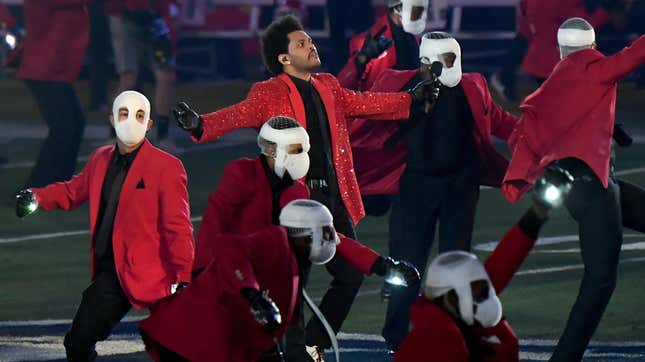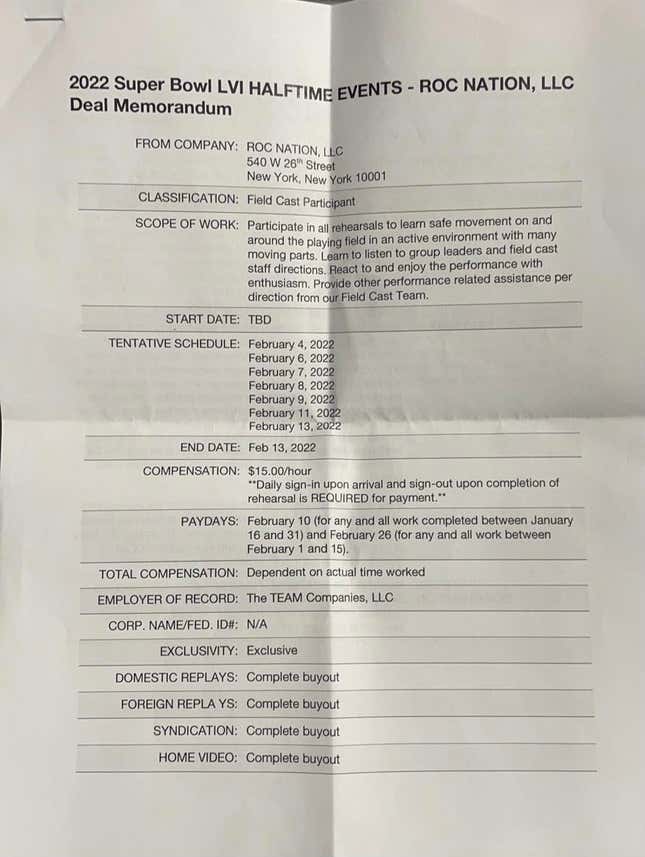Super Bowl Halftime Performers Will Now Be Paid…Minimum Wage
Dance artist and activist Taja Riley filled us in on the latest amidst the NFL’s halftime shitstorm
EntertainmentEntertainment

On Sunday, America will collectively zone out on a high-octane four-hour rumpus with our hands stuffed into a bowl of nacho cheese Doritos. Each year, the NFL’s players, coaches, team owners, league employees, and halftime artists are all compensated handsomely for their contributions in making the Super Bowl the must-see, cultural sporting and entertainment event of the year, responsible for gluing our sedentary asses to the couch for an entire day. Meanwhile, halftime organizers have bestowed upon some 400 professional dancers just $15 an hour (the minimum wage in California)… and a muddled deal memorandum.
The fact that the Super Bowl is now paying the dancers at all is a positive development, considering that the performers had until now been asking them to perform for free — but for their hard-earned contributions to the “greatest show on earth,” dancers are still getting table scraps. As dance artist and activist Taja Riley expressed in an interview with Jezebel on Sunday: “This is a prime example of how we’re taken advantage of.”
In January, Riley, who has toured with Janet Jackson, performed alongside Beyonce in her 2016 Formation Super Bowl halftime show, and danced in Rihanna’s televised Savage x Fenty shows throughout her 16 years in the industry, posted screenshots on Instagram from dancers around the industry who were asked to “volunteer for free” as field performers for the upcoming Super Bowl halftime show. Produced in partnership with Roc Nation and dance agency Bloc LA, the show is set to feature Dr. Dre, Snoop Dogg, Eminem, Mary J. Blige and Kendrick Lamar, along with 115 paid professional dancers. The unpaid “field cast,” on the other hand, would walk away with a sort of gift, instead: a once-in-a-lifetime experience and nationwide exposure. No cash.
In response to dancers’ cries of protest, on Tuesday evening, SAG-AFTRA—the union that covers and protects performers—issued a statement to The Los Angeles Times: “SAG-AFTRA and the producers of the Super Bowl Halftime Show have met and had an open and frank discussion, and have agreed that no professional dancers will be asked to work for free as part of the halftime show. SAG-AFTRA will be advising our professional dancer members that they should not be rehearsing or working on the Super Bowl halftime show without compensation.”
While on the outside, it appeared as if the NFL’s latest scandal (of which there are too many to count!!!) had been resolved with a nice, rosy paycheck, Riley told Jezebel, “It’s not resolved at all.”
Riley provided us with a photo of the field cast’s new deal memo, provided to her by a union-eligible professional dancer, who is represented by a dance agent and is working the halftime show as one of the 400 lesser-paid dancers. The cloudy terms of the memo demonstrate how the dance industry and the entertainment industry at large often collaborate to enforce a belittling pecking order, putting dancers in precarious positions at gig after gig.

For starters, Riley said Roc Nation made the field cast line up and sign the memo on the spot on Saturday without a SAG-AFTRA representative present—a predatory tactic that does not allow dancers time to review the terms of the contract with their agents, counsel, or fellow industry workers. Riley says SAG is not only supposed to approve all union contracts before they are distributed to performers, but that union reps should have been present in case performers had any questions, especially given that Roc Nation had just agreed to cooperate with the union.
“We are in a system of misinformation, and that’s the reason why we’re stuck in this generational curse, because we are bullied or coerced into signing things, before actually reading or reviewing and going over it,” Riley said. “The fact that 300 People went along like sheep lined up behind somebody else that was lined up behind somebody else to sign this, just because everyone else was signing it…that says it all right there.”
Then, there’s the issue of the “classification” field: The memo refers to the dancers as “field cast participant.” But Riley says, by SAG-AFTRA’s own strict standards, dancers can only be classified as “performer” or “extra,” each of which have a minimum pay rate mandated to protect the dancers from unsatisfactory wages. Extras, according to Riley, should be getting at least $20 per hour. This cast of dancers, however, are classified as neither, meaning there’s wiggle room in both the amount they’re paid and the number of hours they can work.
-

-

-

-

-

-

-

-

-

-

-

-

-

-

-

-

-

-

-

-

-

-

-

-

-

-

-

-

-

-

-

-

-

-

-

-

-

-

-

-








































